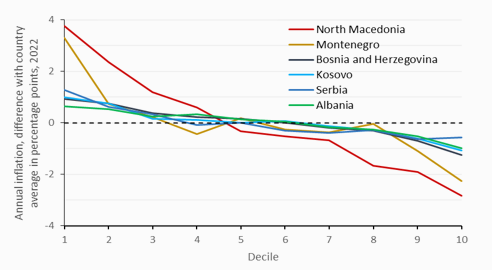In 2022, the six Western Balkan countries – Albania, Bosnia and Herzegovina, Kosovo, Montenegro, North Macedonia and Serbia – saw the resilience of their economies tested by multiple shocks. To promote more inclusive, resilient and sustainable growth in this period of high uncertainty, the region will need to rebuild its fiscal space and undertake reforms, as we explain in our latest report. economic update.
Shaken by crises
Following the rebound in economic activity in 2021, the region’s economies have been buffeted by a challenging external environment resulting from the fallout from Russia’s invasion of Ukraine, rising energy prices and food products, unfavorable weather conditions, tightening financial conditions and great uncertainty.
Despite employment growth, job creation also lost strength in all Western Balkan countries in the second half of 2022. The youth unemployment rate fell to 27% in 2022, but the labor market remains characterized by high inactivity, high and persistent levels of unemployment, high levels of informality, significant skills mismatch and continued emigration.
Inflation also reached a two-decade high in 2022 in almost all economies, with consumer price inflation peaking in late 2022. Although there are signs of easing, inflation trends underlying inflation suggest that price pressures remain widespread and persistent. Although the central banks of Albania, North Macedonia and Serbia have taken steps to tighten monetary policy, conditions nevertheless remain accommodative and real policy rates negative due to rising inflation and expectations of price matter.
The poorest households were hit hardest
Our analysis shows that the actual cost of living increases faced by the poorest households in the Western Balkans are much higher than official consumer price inflation figures suggest. Poorer households spend a much higher share of their income on food and energy, the two elements of the consumption basket whose prices increased the most in 2022. In North Macedonia, this disparity is the highest in the region: the cost of living for the poorest is seven percentage points higher than for the highest income households.
Chart 1. Cost of living inflation varies by household
Annual inflation of the cost of living by decile in WB6

Source: World Bank staff calculations based on Lokshin et al. (2023).
Note: This figure represents annual cost of living inflation by decile for December 2022. Inflation by decile is expressed as a difference from average cost of living inflation.
This cost of living crisis has also changed the pace of poverty reduction in the region. Due to lower economic growth and higher inflation, poverty is estimated to have fallen by just 1 percentage point in 2022, the equivalent of 160,000 people lifted out of poverty in 2022, which is much less than during the pre-pandemic period.
Building a more resilient Western Balkans
With economic growth in the Western Balkans expected to reach 2.6% in 2023, an uncertain global growth environment and geopolitical context will continue to test the resilience of the region’s economies. To build resilience to shocks and protect the most vulnerable, governments in the region should consider:
- Rethinking the design of social assistance: To alleviate the cost of living crisis, governments in the region should take into account the different cost of living inflations faced by households when developing effective policies aimed at protecting the most vulnerable households and avoiding a further erosion of social assistance programs. Governments should also consider designing effective energy vulnerability programs that would enable low-income households to become affordable.
- Protect human capital: Given the learning losses accumulated during Covid-19 lockdowns, it is imperative to strengthen education budgets and outcomes. There is also a need to focus on tackling youth unemployment to prevent emigration, as well as on the employability and activation of welfare recipients to protect them from long-term unemployment and erosion. skills.
- Transition to greener energy sources: The current energy crisis has highlighted the need to accelerate the green transition across Europe, including the Western Balkans. A key starting point in this regard is to accelerate the move towards carbon pricing and increase the use of environmental tax measures that incentivize households and businesses to adopt lower carbon intensity with respect to ‘economic activity.
- Increase productivity: Accelerating regional integration, increasing levels of market competition and removing barriers that limit labor market participation – particularly for women – will also help boost productivity.
